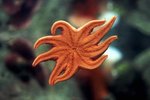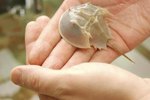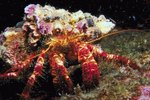
Sea urchins are spiny, hard-shelled marine creatures found on rocky ocean floors worldwide. About 700 different species of sea urchins are known to exist throughout the world, having varied body colors, shapes and sizes. The sea urchins belong to phylum Echinodermata and are often referred to as echinoids. They are about 4 to 5 inches in length. Humans feed on sea urchins, which are considered a delicacy in Japan.
Body Structure
Sea urchins have a shell called a test, which comes in colors as varied as black, green, brown, purple and red. The test is made up of magnesium calcite plates fused together beneath the skin. It has two major openings: the peristome, which is the mouth located on the underside, and the periproct, which consists of the anus and genital pores located on the urchin's top. The tests of regular urchins are generally spherical, whereas in irregular urchins the tests are flattened. The mouth of a sea urchin is claw-like, with five toothy plates called "Aristotle’s lantern," as they resemble this type of old oil lamp.
Feeding
Sea urchins are omnivorous creatures, feeding on both animal—remains of dead fish, sponges, and mussels—and plant matter. Sea urchins contribute greatly to algae regulation in the ocean, as this is their favorite food. Different species of echinoids have different modes of feeding. Regular echinoids utilize their strong internal jaw to feed on sedentary organisms and algae. Irregular echinoids such as the heart urchin feed by ingesting sediments directly, or on particles deposited on their body surfaces.
Defense
The long spines that radiate from an echinoid’s body are used as a means of protection. Other uses of the spines include movement and trapping food. The spines of the urchins have little claw-like structures referred as pedicellarines that are used for protection, assist in trapping food and help to keep the body of the urchin clean. Sometimes the echinoids use camouflage to hide from predators if their color is similar to that of their habitat.
Reproduction
Reproduction occurs in spring and fertilization is external. The female sea urchin ejects millions of small jelly-coated eggs into the water. The male sea urchin then fertilizes the eggs by the release of sperm. The eggs hatch tiny larvae known as pluteus that settle in the sea becoming a juvenile sea urchin. Urchins develop in several larval stages that vary by species. It takes between two to five years for the sea urchin to mature.
References
Photo Credits
-
Comstock Images/Comstock/Getty Images
Writer Bio
Kendal Elizabeth has been a professional writer and editor since 2001. She has specialized in writing pet-related topics, home decor and gardening. Her work has appeared on several online and offline publication. Elizabeth holds a Bachelor of Science in Animal Science with a minor in marine biology from Cornell University.




